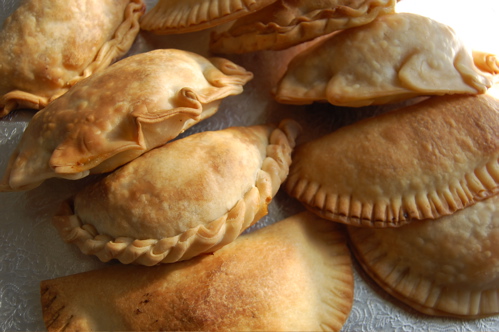 |
| Picture courtesy of: dft.ba/-2luc |
On the top of one's tongue there is a collection of organs known as gustatory calyculi or, more commonly, taste buds. The tongue is home to approximately 100,000 individual taste buds. Each of these buds contains about 50-100 cells known as "taste cells" each of which, contrary to popular belief, can perceive a variety of flavors. These cells have a life span of 1-2 weeks before they die and are replaced. There are additional buds on the top, sides, and rear of the mouth, along with the throat. The gustatory calyculi are able to perceive five different types of flavor; bitter, sweet, salty, sour, and savory (often referred to as "umami," a Japanese word that means savory).
Bitter
 |
| Some examples of bitter foods |
 |
| Some examples of sweet foods, specifically candies |
Sweet food perception also occurs on G-protein-coupled receptors, specifically T1R2+3 and T1R3. It also involves combining the foodstuff with gustductin. How sweet the substance is perceived as depends on how tightly it binds with the two receptors.
Salty
 |
| Table salt, or NaCl, commonly found in salty foods |
The flavor of sour foods is caused by their acidity. Acidity of a substance is relative to its number of H+ ions, so it is natural that these ions would be the cause of the sour perception. The taste cells perceive sour by expressing the protein PKD2L1. However, the H+ ions themselves can also illicit the taste response, so this gene is not required for this taste perception.
The perception of the umami taste comes from glutamic acid salts (for example, MSG, which is often found in chinese food). This once again occurs on the G-protein-coupled receptors, specifically the glutamate receptors, subsets T1R1 and T1R3.
Supertasters
One of the most fascinating evolutionary phenomena associated with taste is that of the supertasters. It is believed that this anomaly is caused by an increased amount of taste buds present on the tongue. The first mention of the term "supertaster" was in a study conducted by Linda Bartoshuk. She was conducting a study on taste perception in the 1990s, when her research team noticed that some of the participants had increased response to tastes. As previously mentioned, the ability to taste the chemicals PTC and PROP have been linked with the ability to super taste. It appears that this specific taste receptor comes from one gene (TAS2R38). People who express this genotype prefer sweets as children, do not enjoy alcohol as much as their counterparts, less vegetable consumption, and a lessened tendency to smoke. It is estimated that 25% of people are are supertasters, 50% are regular tasters, and another 25% have a decreased number of taste buds.
If you don't have access to PROP or PTC, here's a quick and easy test to see if you are a supertaster:
Step 1:
Using blue food color or a blue lollipop, stain your tongue blue.
Step 2:
Place a piece of hole punched paper on your tongue, making sure that the hole is on top of the blue stained area.
Step 3:
Look in the mirror. Using a magnifying glass, count the number of papillae you see. (Unlike the rest of your tongue, the papillae will be unstained).
If there are more than 35, you are likely a supertaster. If there are 15-35, you are a medium taster, If there are less than 15, you are a non-taster.
Fun Facts:
-Women are more likely to be supertasters than men
-Asians, Africans, and South Americans are also more likely to be supertasters
-The bass player for the band Muckaferguson is a supertaster. They Might Be Giants wrote a song about him (John Lee Supertaster)
-Supertasters like salty foods
-Supertasters are less likely to enjoy fatty and sugary foods
-Supertasters are generally more skinny than regular tasters because they do not enjoy many unhealthy foods, however, they have elevated risk of colon cancer because they do not enjoy bitter vegetables
Still unsure if you're a supertaster or regular taster? Try this test, provided by the BBC.
Sources:
http://users.rcn.com/jkimball.ma.ultranet/BiologyPages/T/Taste.html
http://faculty.washington.edu/chudler/tasty.html
http://en.wikipedia.org/wiki/Taste
http://en.wikipedia.org/wiki/Supertaster#Identifying_a_supertaster
http://www.todayifoundout.com/index.php/2010/06/how-to-tell-if-you-are-a-supertaster/
http://www.npr.org/templates/story/story.php?storyId=127914467
http://www.bbc.co.uk/science/humanbody/body/articles/senses/supertaster.shtml
Images:
http://hecooksshecooks.net/wp-content/uploads/2009/05/bitter-foods.jpg
http://www.virginmedia.com/images/ysp%20food%206%20sweets%20on%20la%20rambla,%20barcelona%20by%20helen%20sandell.jpg
http://whatscookingamerica.net/Information/Salt1.jpg
http://www.petitekitchenesse.com/wp-content/uploads/2010/10/fruit.jpg
http://joepastry.site.aplus.net/pics/empanadas1.jpg
http://blogsoop.com/blog/wp-content/uploads/2007/07/supertasters_supertaster.jpg
Images:
http://hecooksshecooks.net/wp-content/uploads/2009/05/bitter-foods.jpg
http://www.virginmedia.com/images/ysp%20food%206%20sweets%20on%20la%20rambla,%20barcelona%20by%20helen%20sandell.jpg
http://whatscookingamerica.net/Information/Salt1.jpg
http://www.petitekitchenesse.com/wp-content/uploads/2010/10/fruit.jpg
http://joepastry.site.aplus.net/pics/empanadas1.jpg
http://blogsoop.com/blog/wp-content/uploads/2007/07/supertasters_supertaster.jpg


